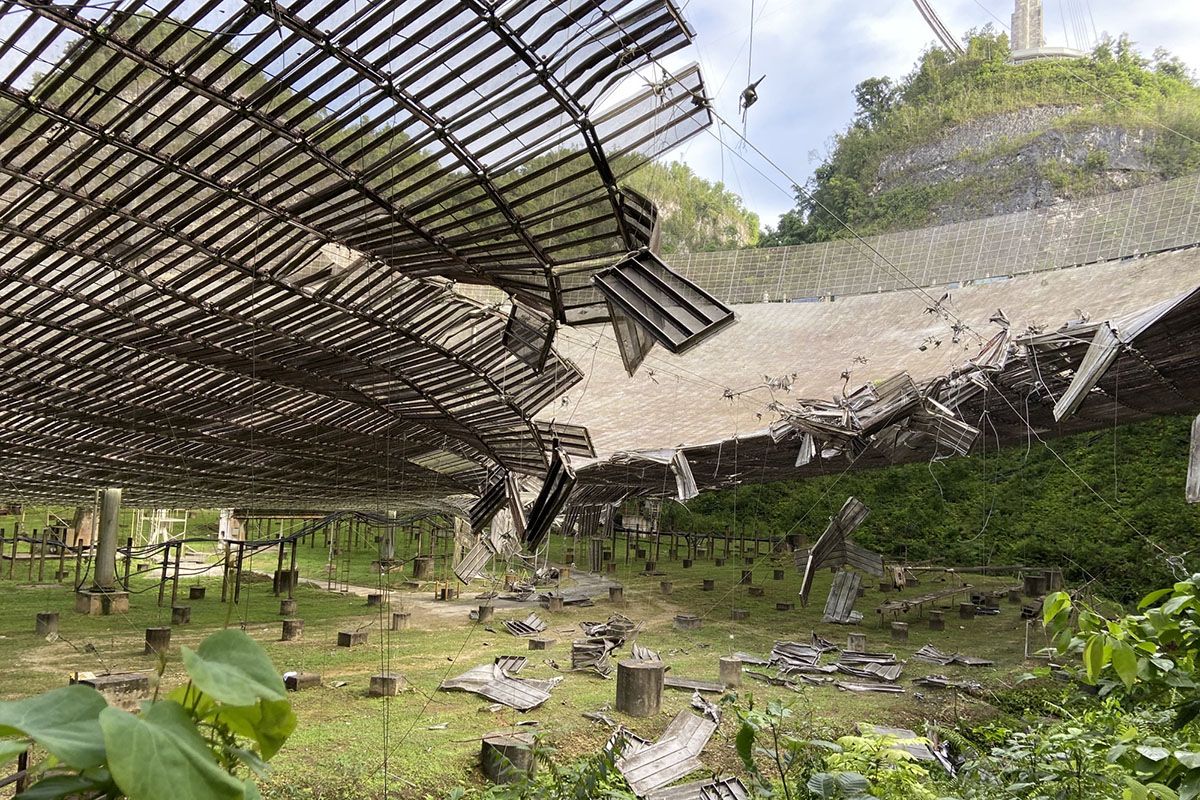
The collapse of the iconic radio telescope at the Arecibo Observatory in Puerto Rico last month has left astronomers with a host of questions about what went wrong and what comes next.
During a virtual town hall event held at the 237th conference of the American Astronomical Society on Monday (Jan. 11), officials at the National Science Foundation (NSF), which owns the facility, offered the most detailed recounting to date of the events that led to the telescope's uncontrolled collapse on Dec. 1.
The event was the agency's first presentation targeted to researchers since the facility collapsed, and officials emphasized their connection with scientists around the world who had ties to Arecibo. "We at NSF are extremely grateful that the safety zones were adequate and that nobody was physically hurt," Ashley Zauderer, the program director for the Arecibo Observatory at the NSF, said during the presentation.
Related: Losing Arecibo Observatory would create a hole that can't be filled, scientists say
"I say 'physically hurt' because we do want to clearly communicate that we understand that this was a very traumatic event, impacting a lot of people," Zauderer said. "There is a lot of hurt."
Zauderer's comments focused on giving astronomers a detailed sense of the events surrounding the collapse, with a timeline beginning in 2017, when hurricanes Irma and Maria battered Puerto Rico. The facility was preparing to begin repair work on resulting damages when a cable failed in August. (The hurricane repairs included replacing another cable connected to a different support tower than the cables that ultimately failed as the collapse scenario unfolded.)
But then, before dawn on Aug. 10, one of the massive cables holding up the 900-ton science platform slipped out of its socket. Engineers evaluated the situation, determined the structure should still be steady, and began devising a repair strategy. Meanwhile, the investigation into what went wrong began as well, Zauderer said.
"That failed socket was removed and sent to the NASA Kennedy lab for forensics in early October to try to understand why did this fail and then help us understand are other sockets also potentially at risk," she said.
Again, a repair plan came together and the facility prepared to begin work only to have disaster strike again, when another cable attached to the same tower broke on Nov. 6. In the wake of the second failure, NSF concluded there was no safe way to stabilize or rescue the facility and began evaluating ways to decommission the telescope in a controlled manner, a decision it announced on Nov. 19, although Zauderer told gathered astronomers that the NSF was still holding out hope.
Related: Puerto Rican scientists mourn loss of Arecibo Observatory's iconic telescope
"Even though we said we were planning to decommission at that point, we were still looking to get more information such that if new information came to light that there was a safe way to repair the telescope, we were ready to shift," she said.
That shift was never possible; the platform collapsed through the 1,000-foot-wide (305 meters) dish below it on Dec. 1, destroying the radio telescope.
"It's not what any of us wanted," Zauderer said. "NSF worked very hard since August to enable a stabilization plan."
The site's future is still unknown, although Congress has joined astronomers and Puerto Ricans in asking for an update about the facility — what happened, what NSF wants to do with the observatory and associated cost estimates — by the end of February. The request comes as part of the omnibus bill that funds the agency through this fiscal year, which ends on Sept. 30; Ralph Gaume, director of NSF's Division of Astronomical Sciences referenced the congressional request during the town hall but did not provide details about how NSF will fulfill it.
Zauderer told Space.com that teams began evaluating how to safely clean up the site on the day of the collapse. "Work is proceeding very actively, but will take a long time due to the quantity of debris and the need to proceed safely and with appropriate environmental protection measures," she wrote.
But Zauderer did note during the presentation that the collapse did not completely destroy the iconic dish of the radio telescope. "About 50% of the reflector is still intact," she said. "We are considering, at this point, weighing the pros and cons of keeping part, rebuilding or what can be done with that."
Email Meghan Bartels at mbartels@space.com or follow her on Twitter @meghanbartels. Follow us on Twitter @Spacedotcom and on Facebook.
"still" - Google News
January 14, 2021 at 07:44PM
https://ift.tt/2N5VRgj
Astronomers are still reeling from the loss of iconic Arecibo radio telescope - Space.com
"still" - Google News
https://ift.tt/35pEmfO
https://ift.tt/2YsogAP
Bagikan Berita Ini















0 Response to "Astronomers are still reeling from the loss of iconic Arecibo radio telescope - Space.com"
Post a Comment